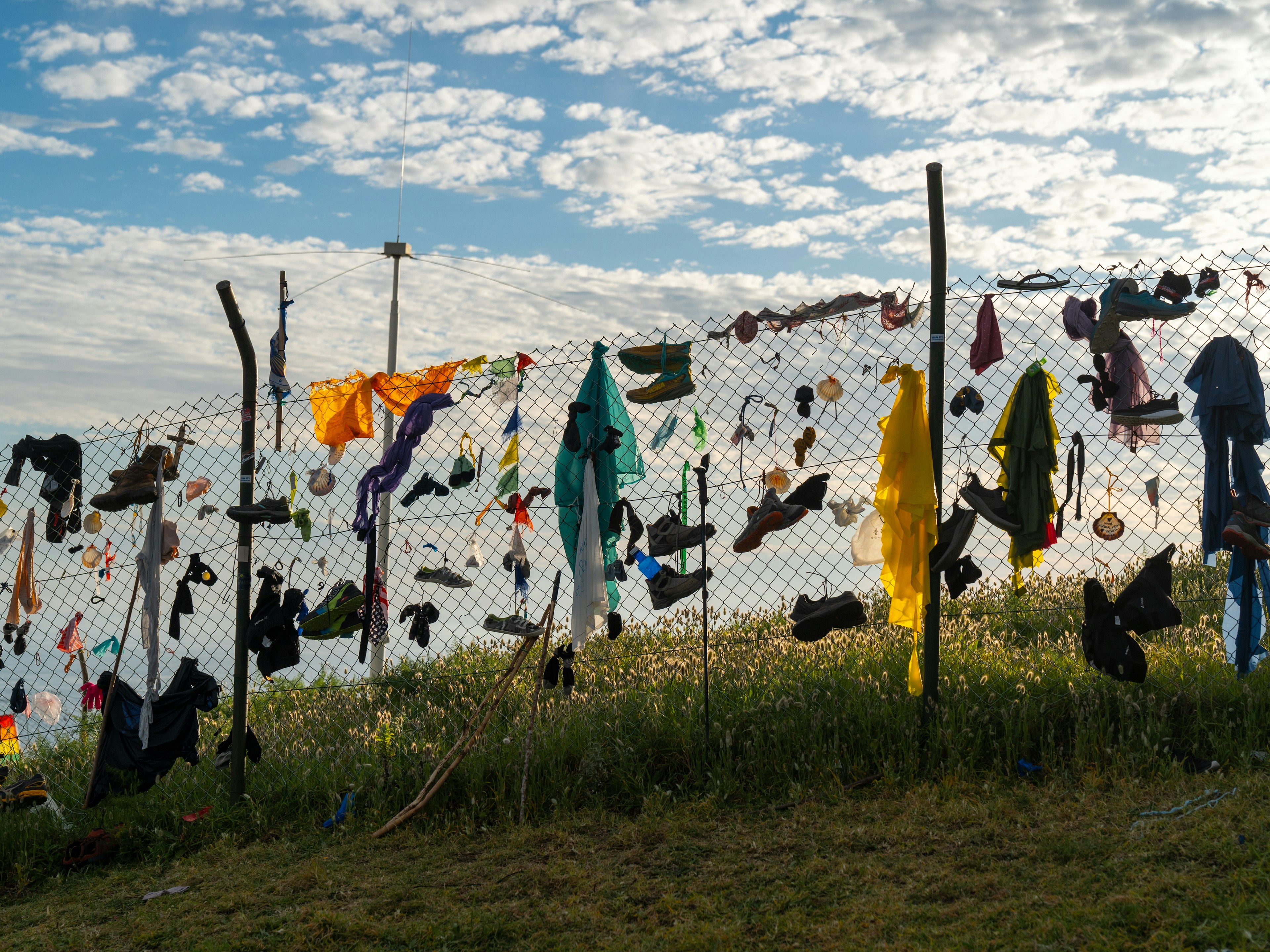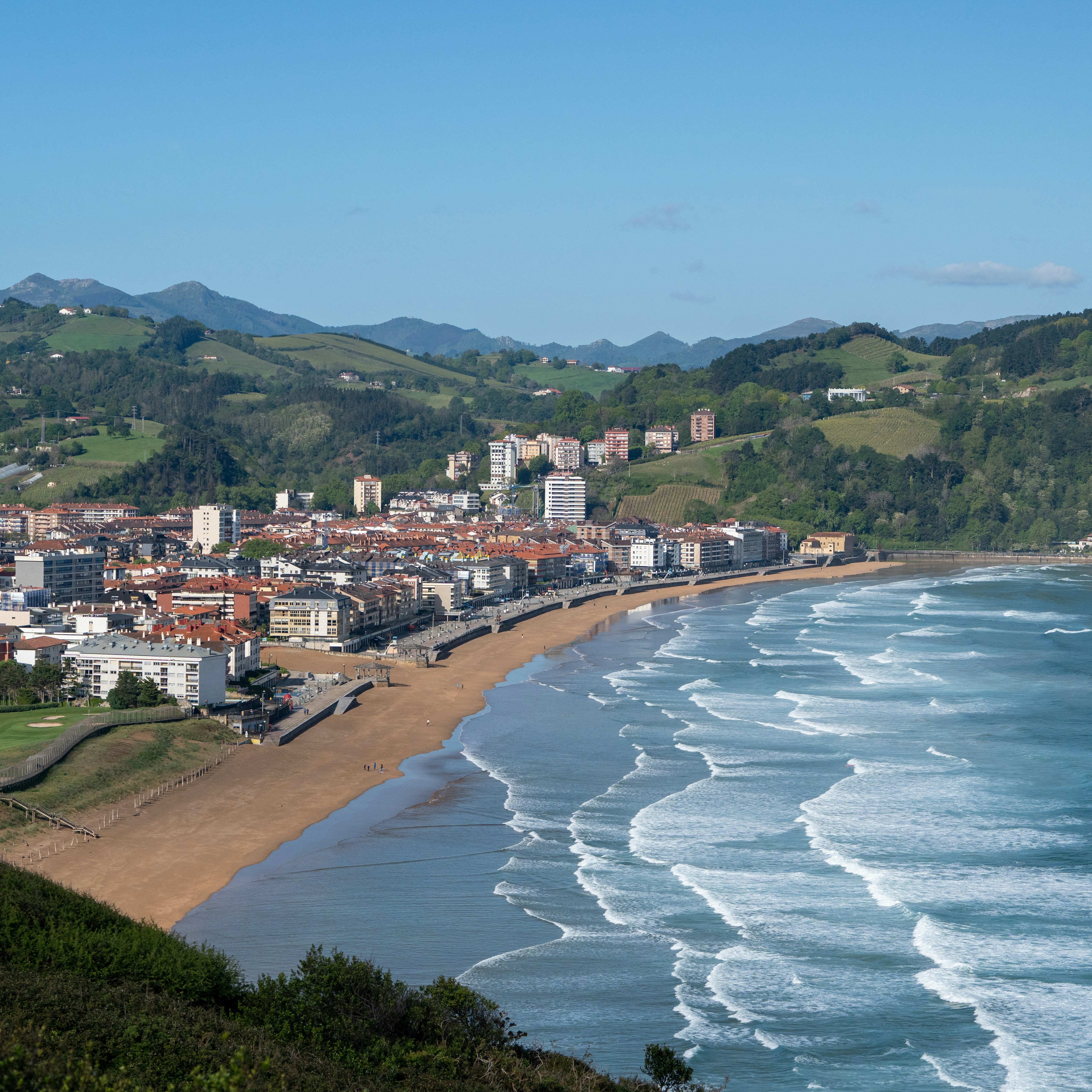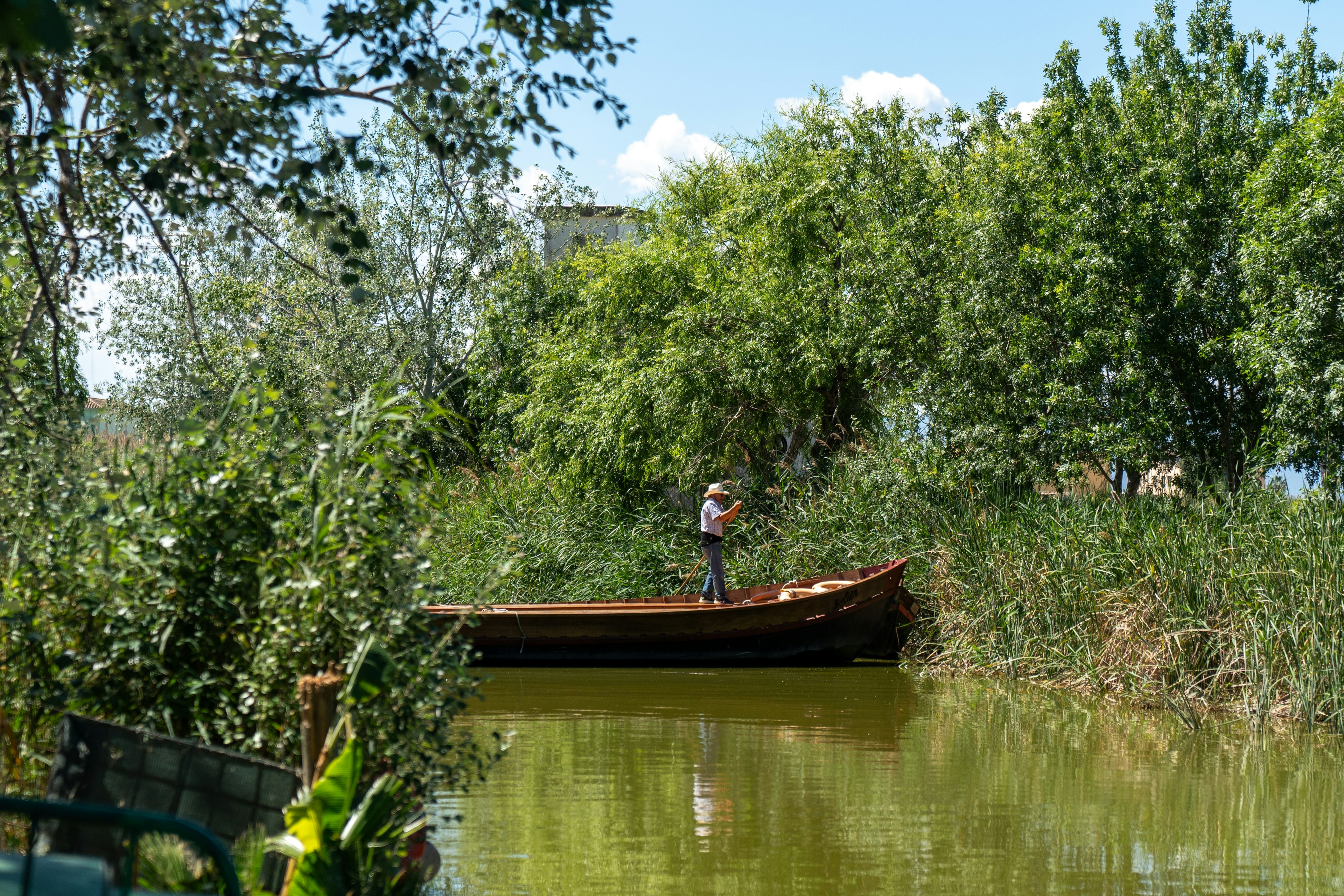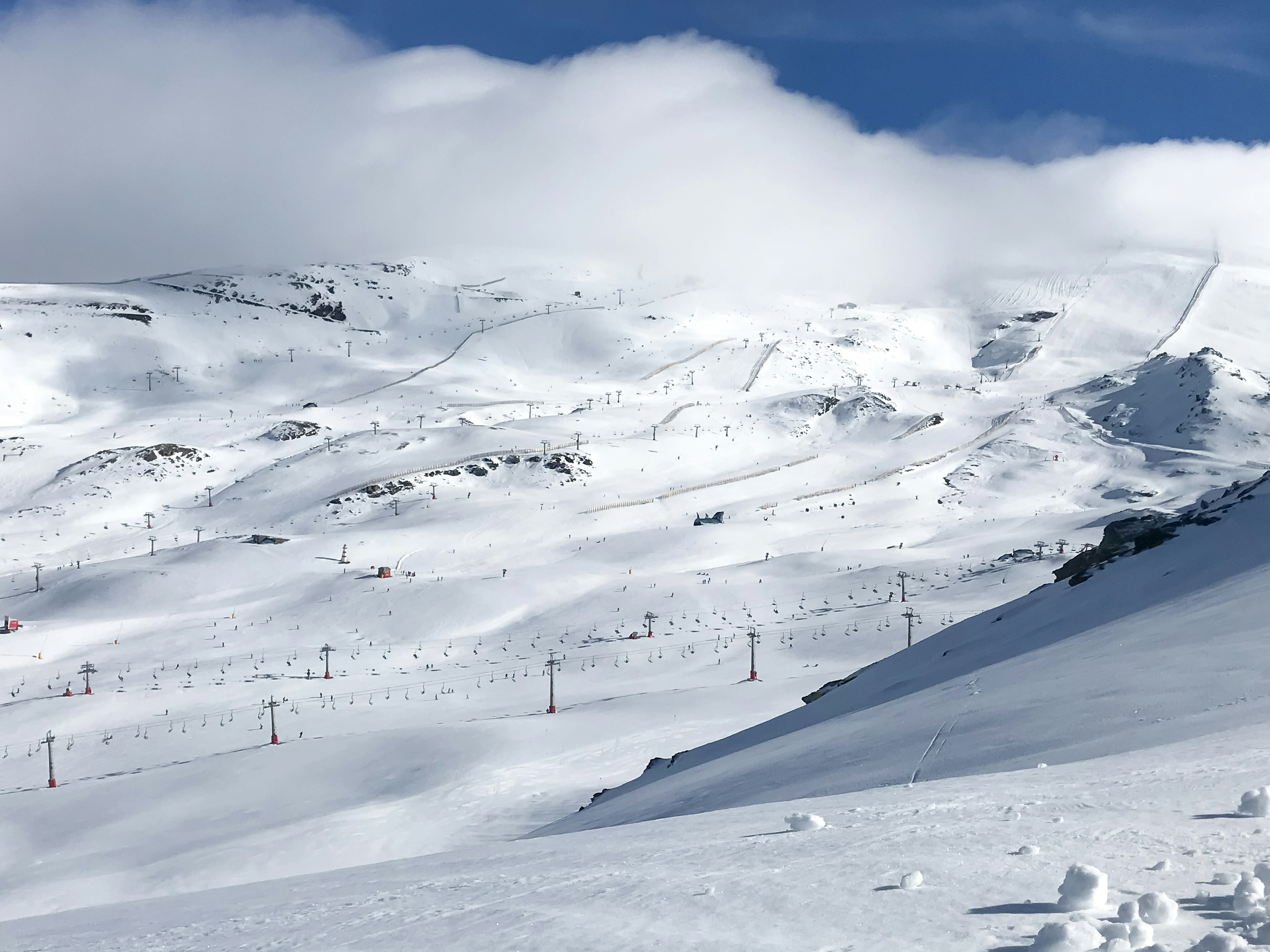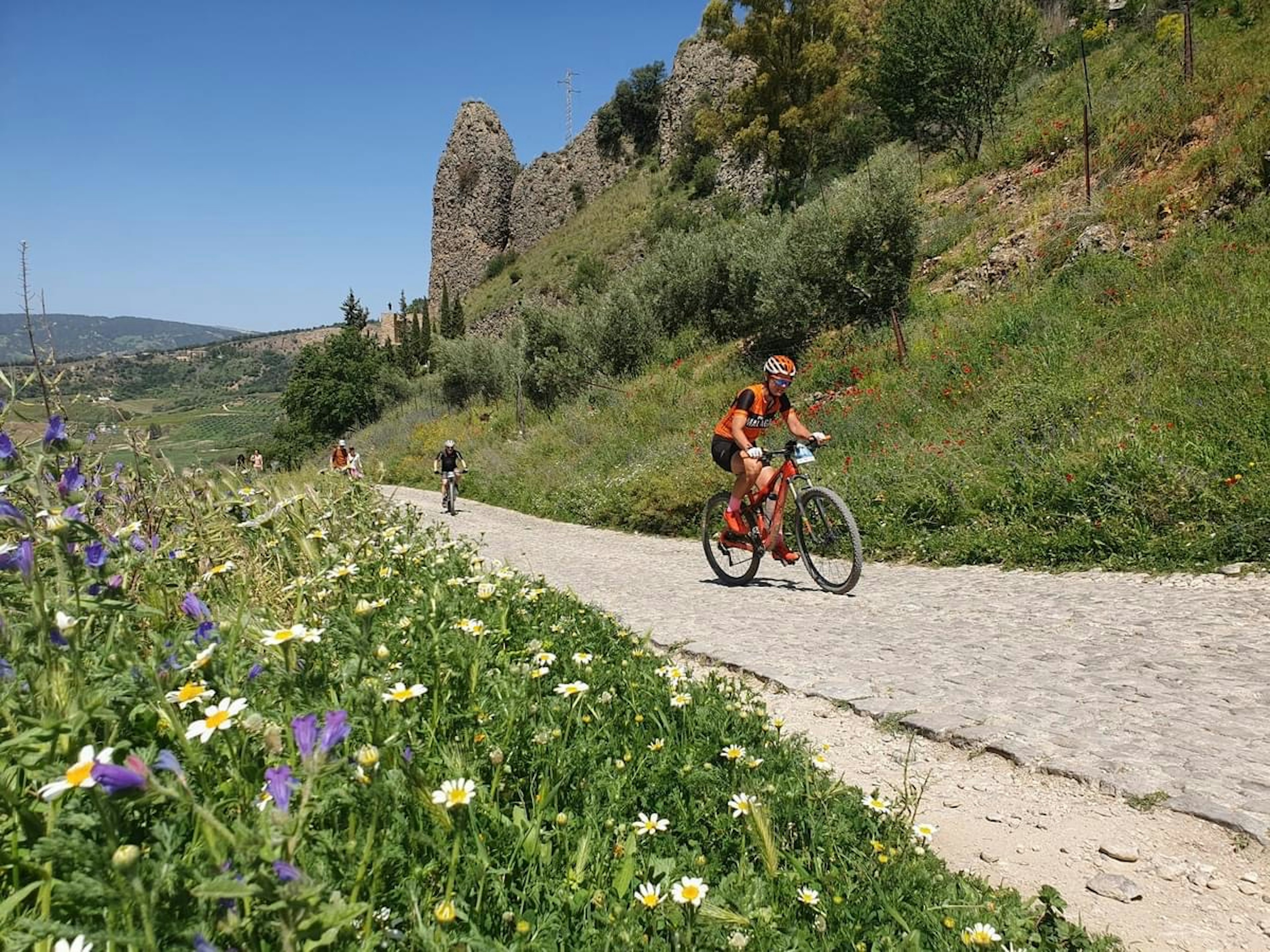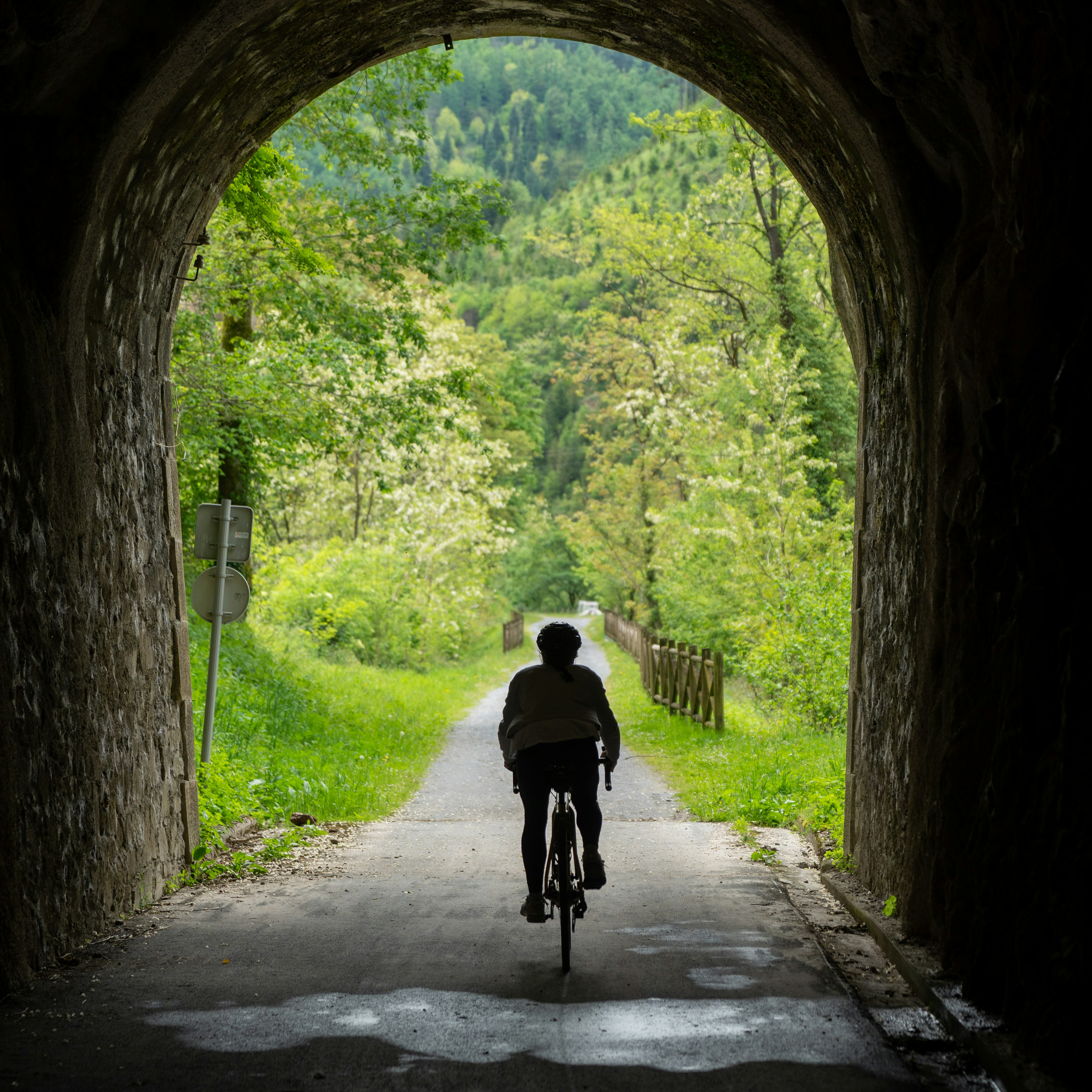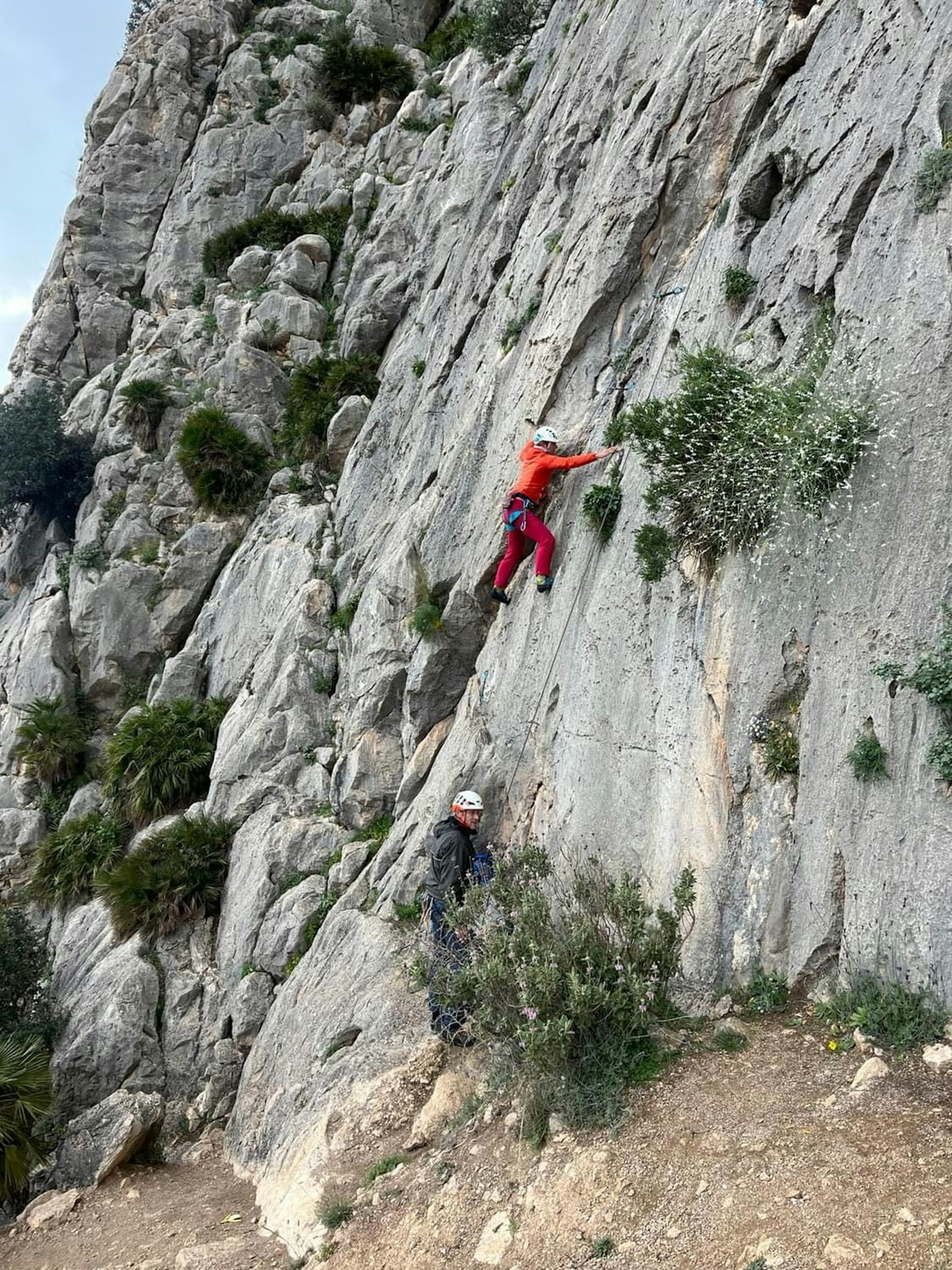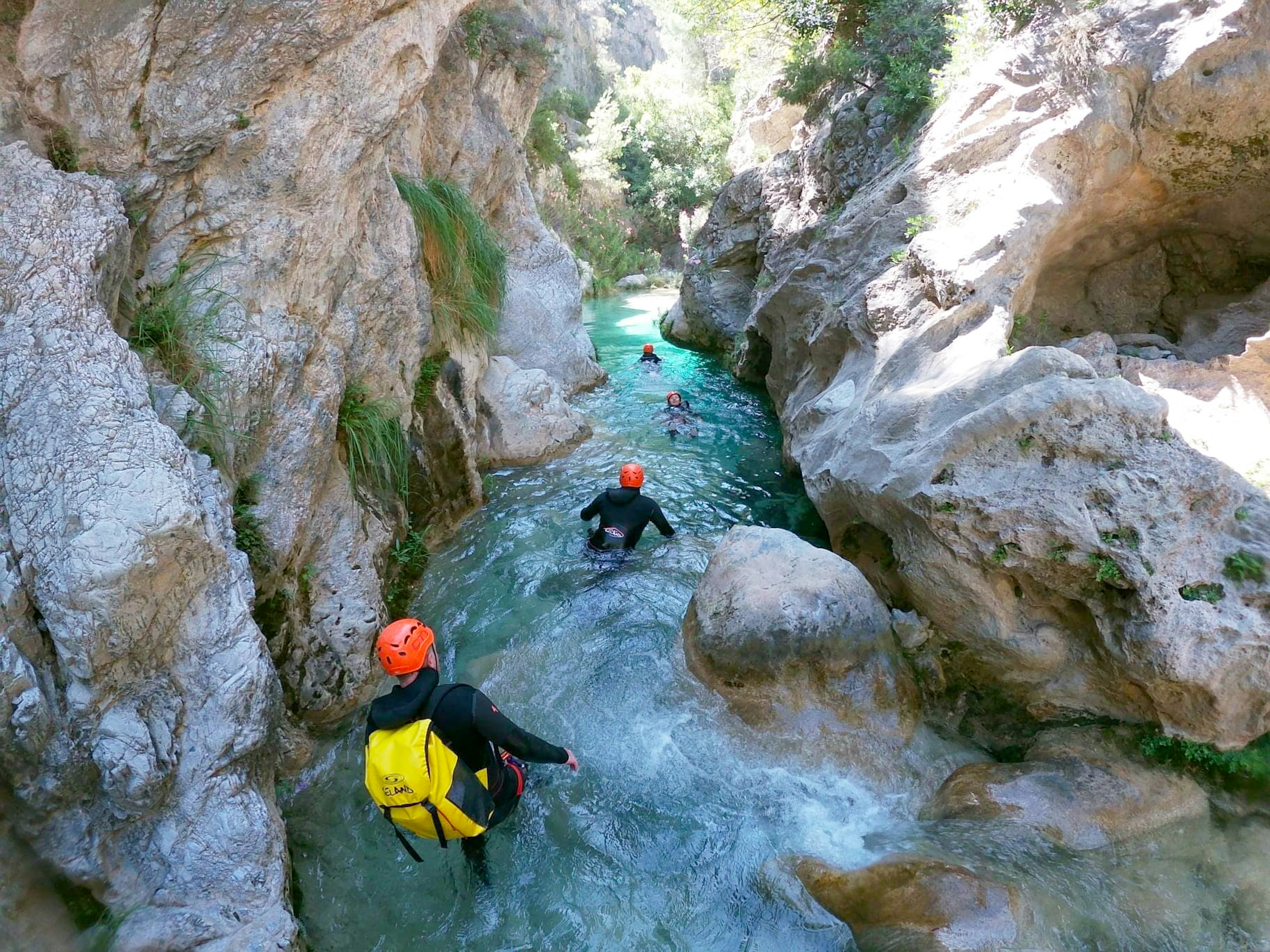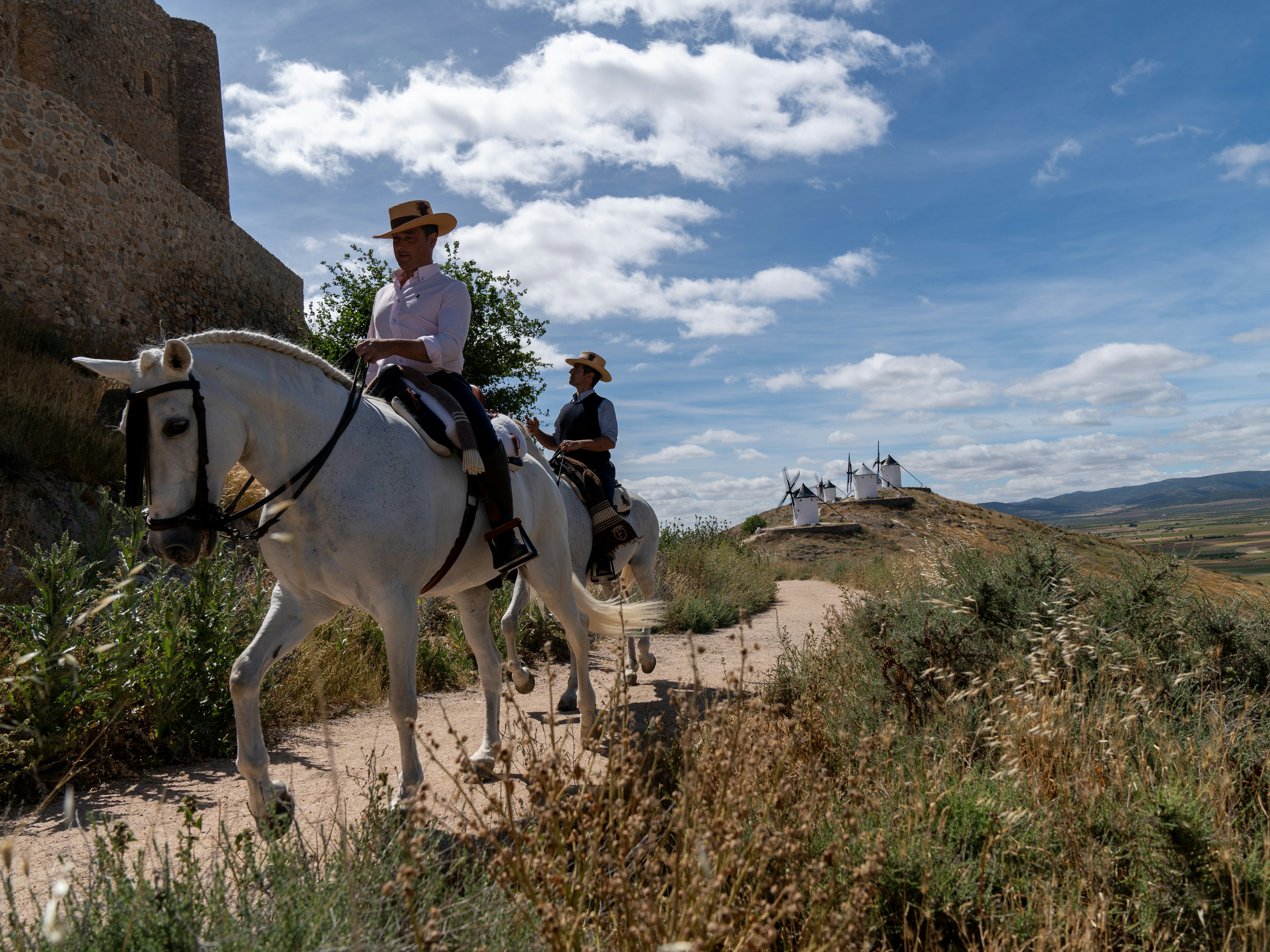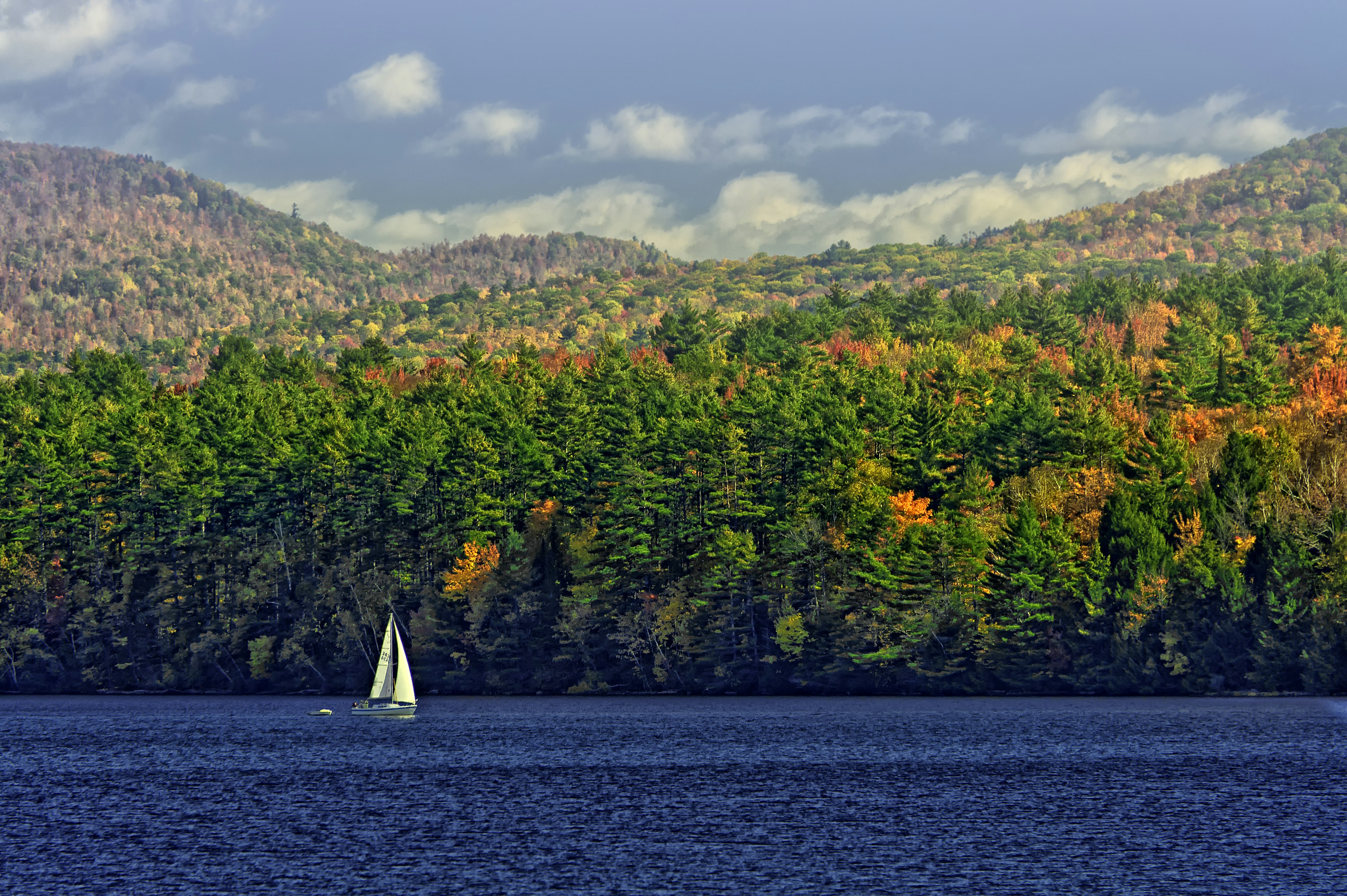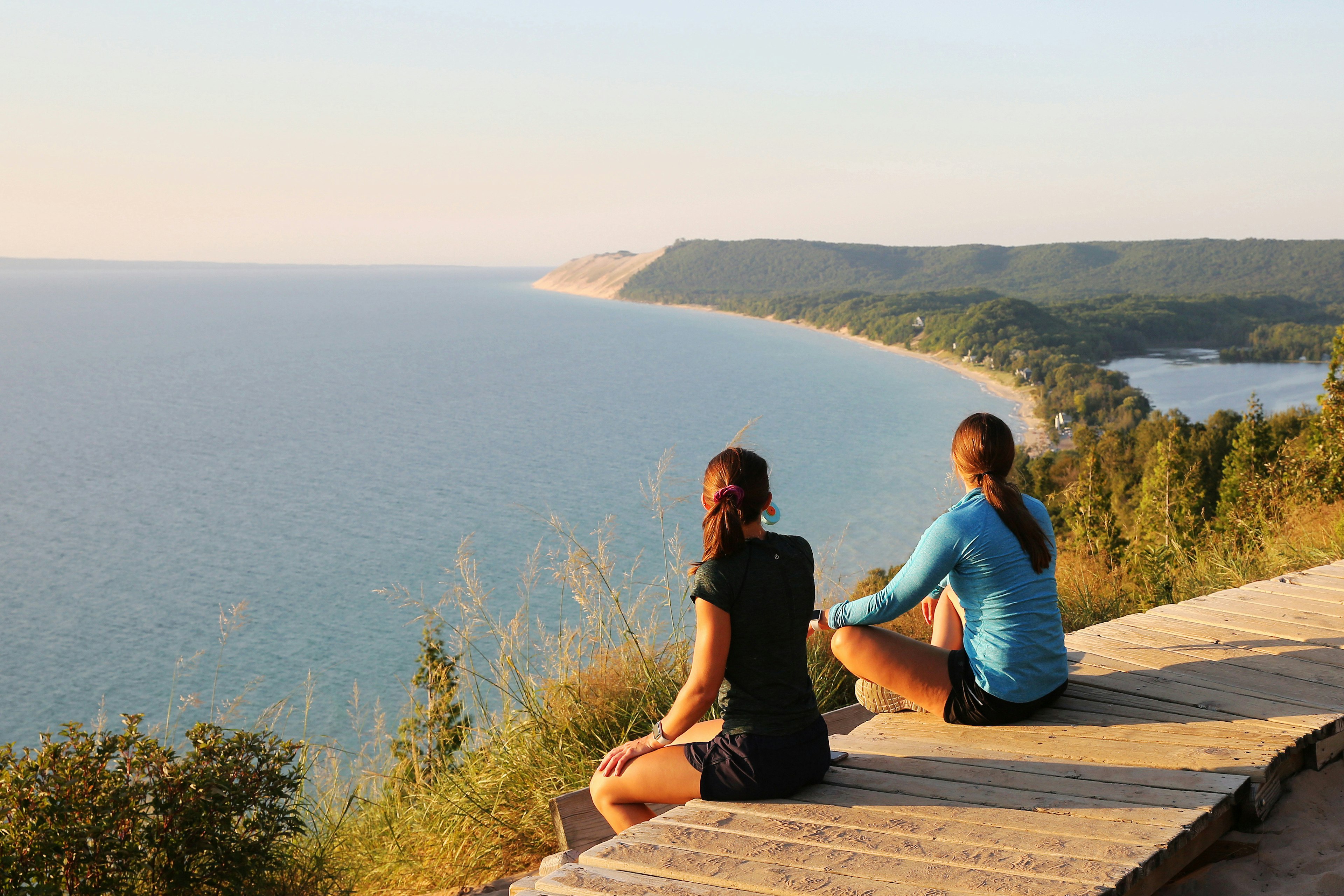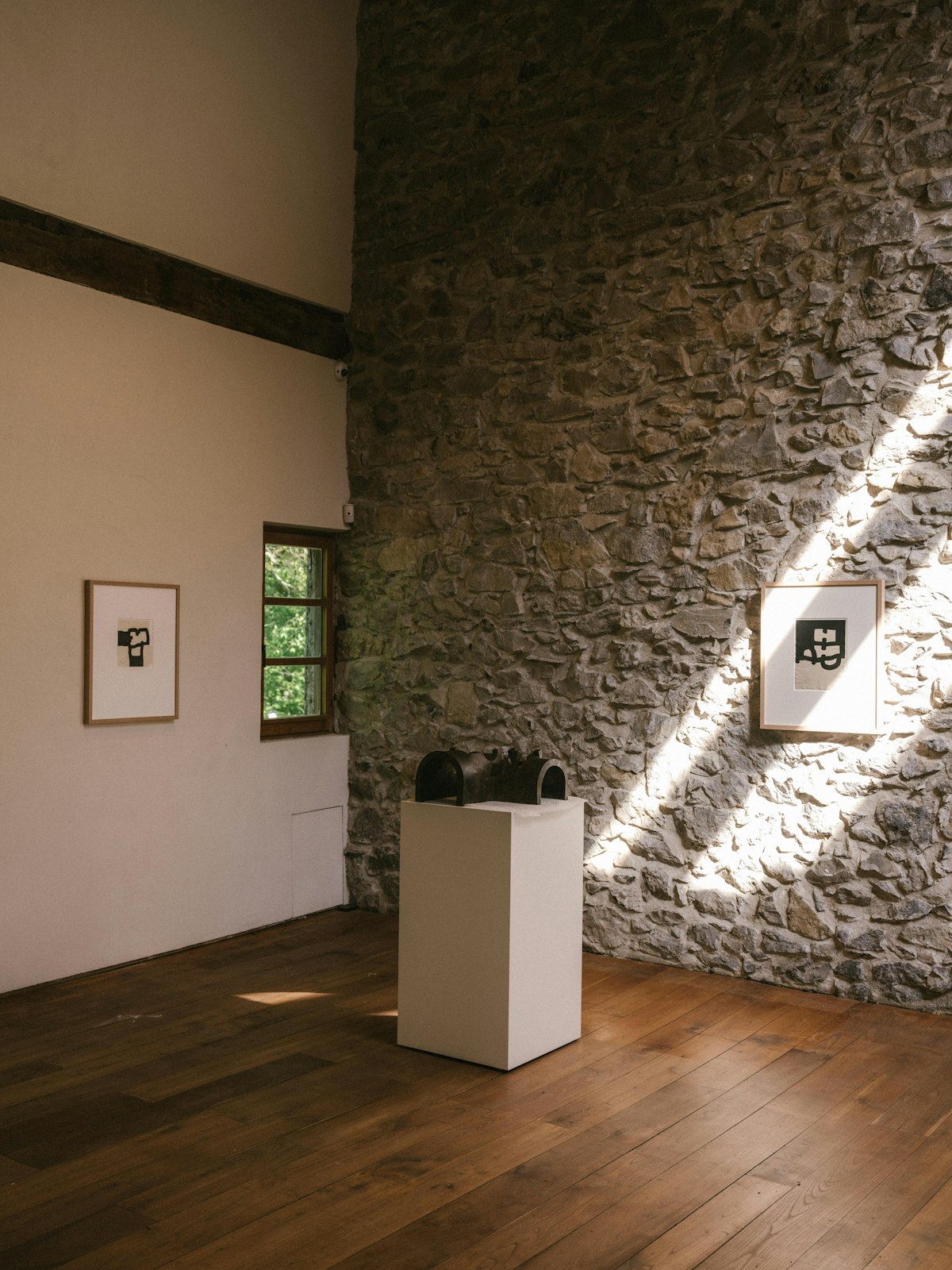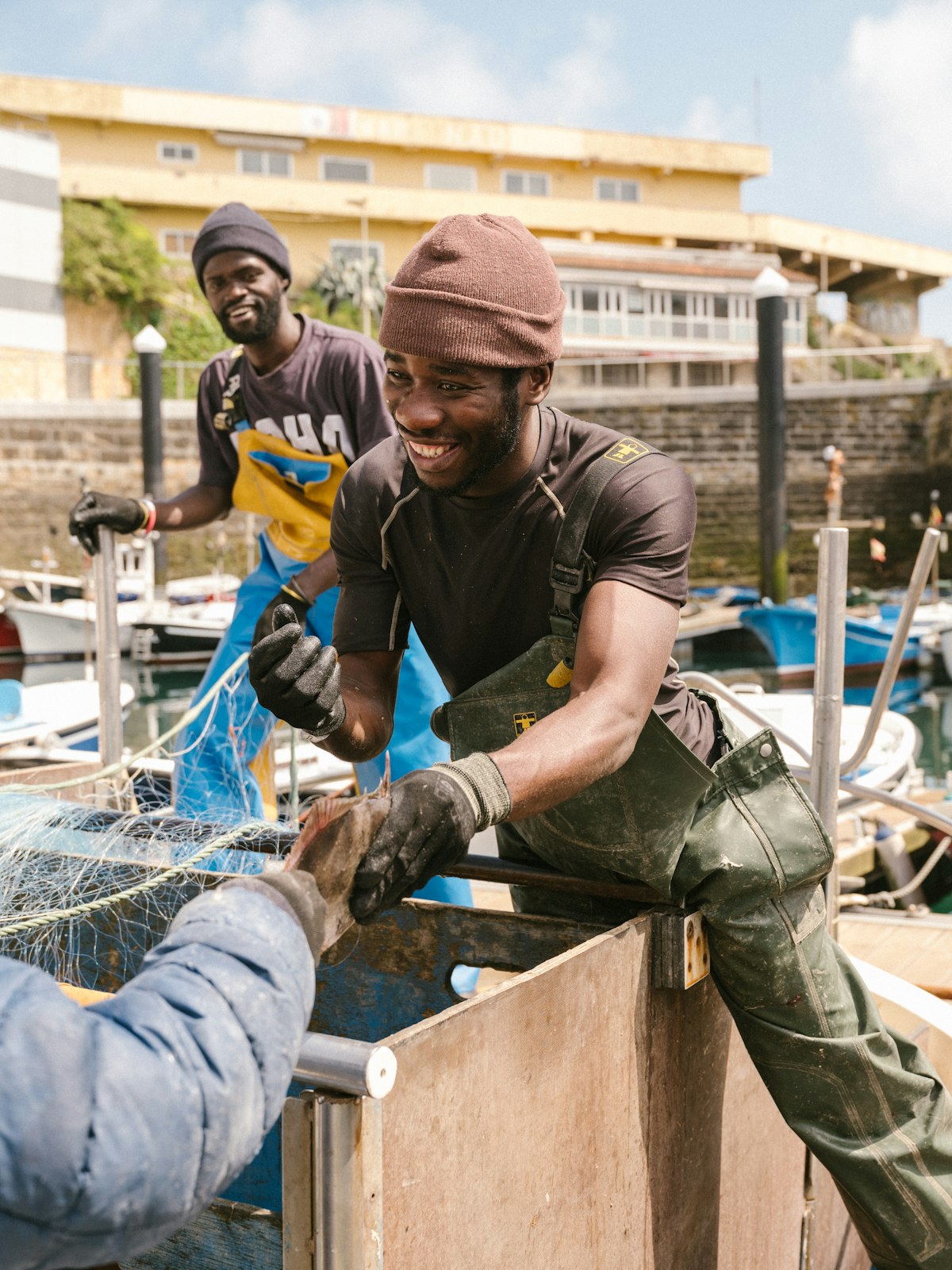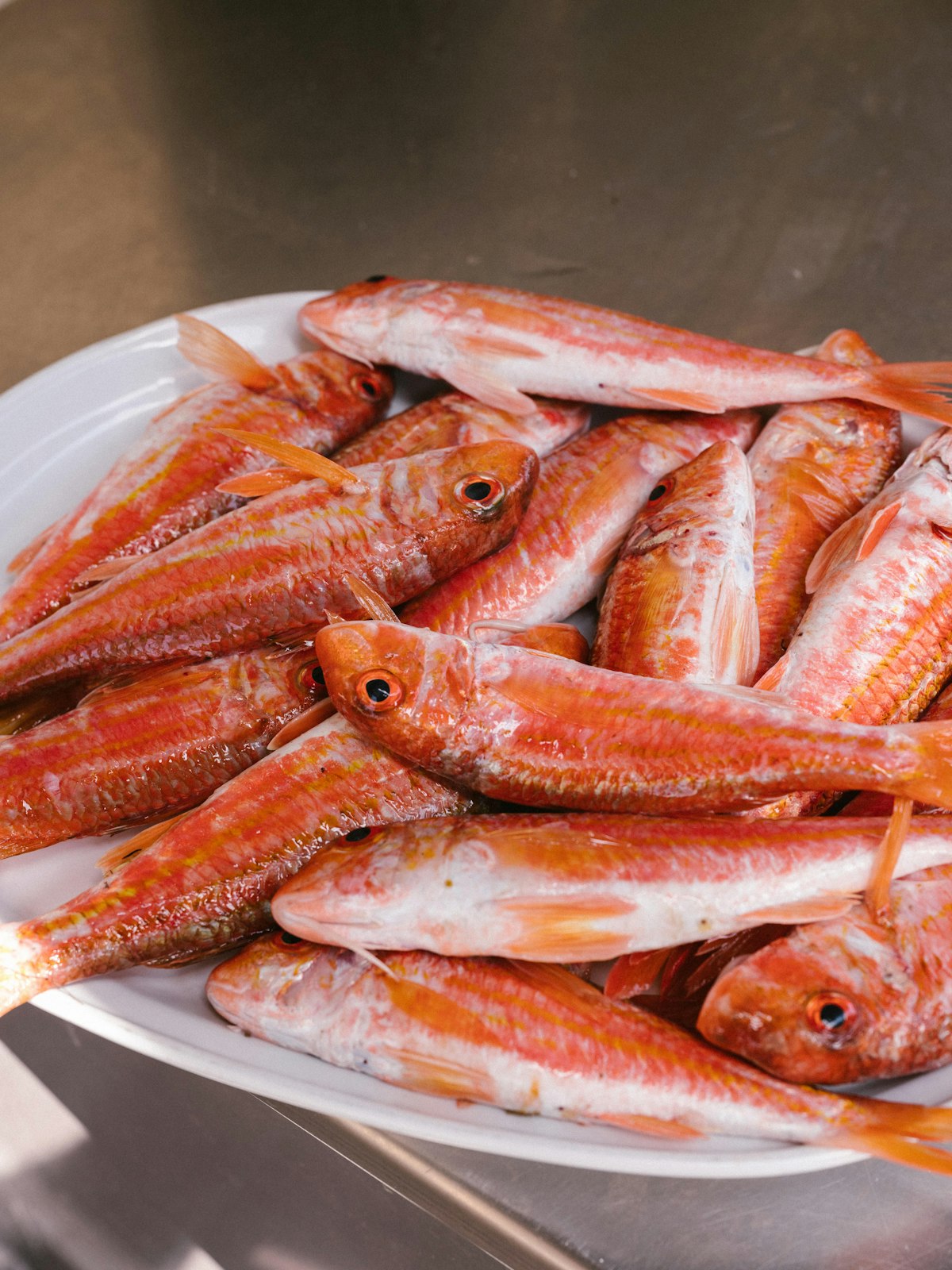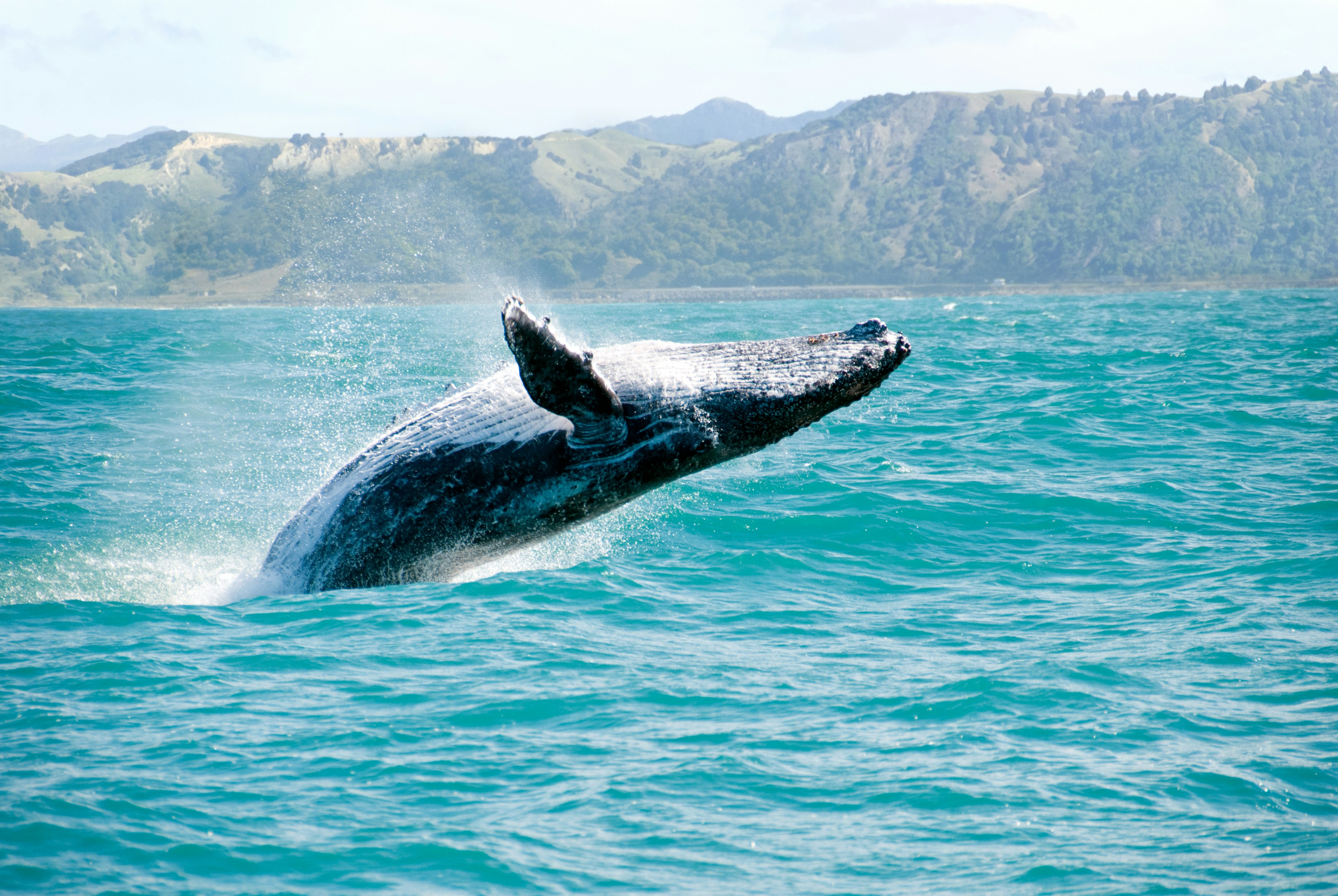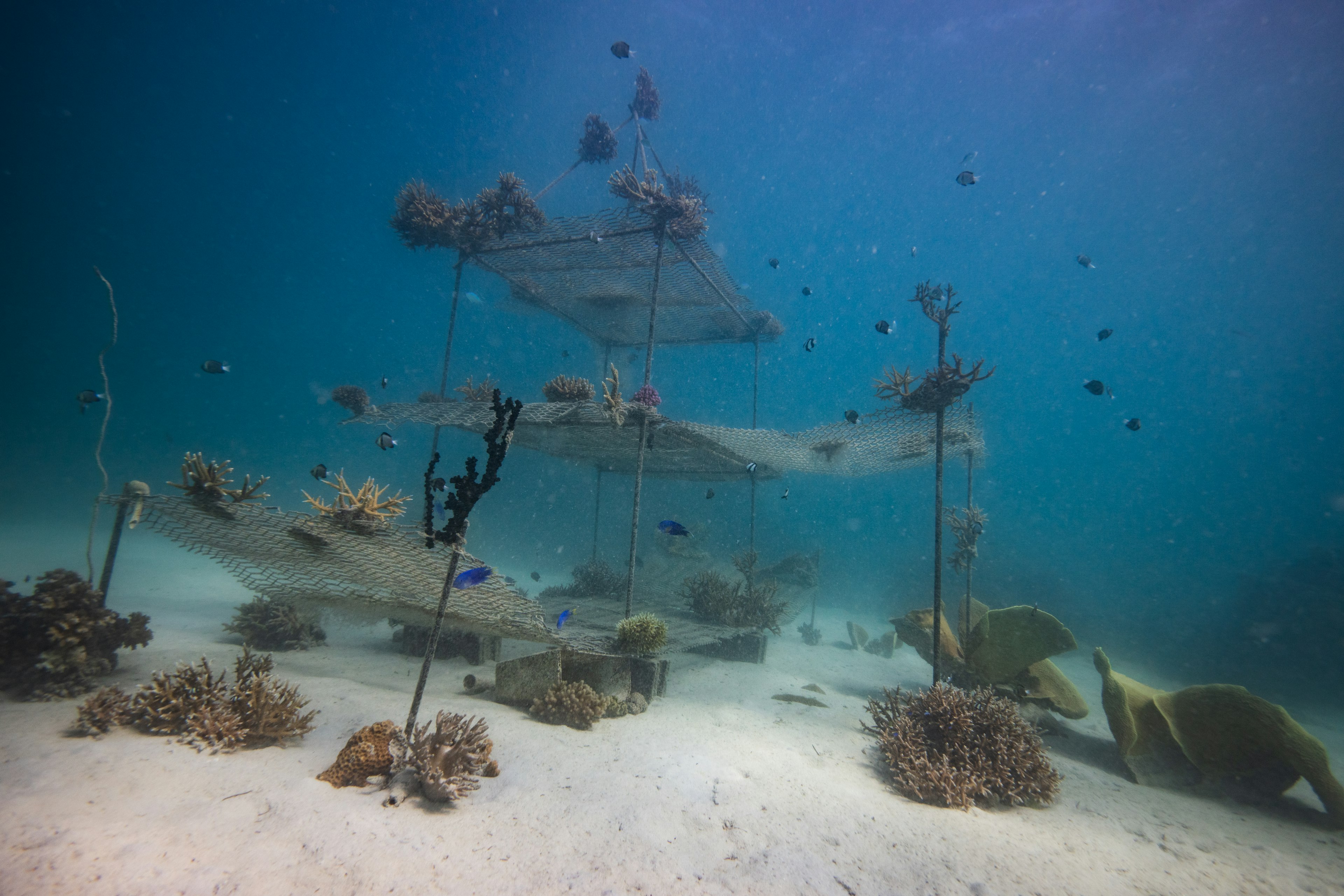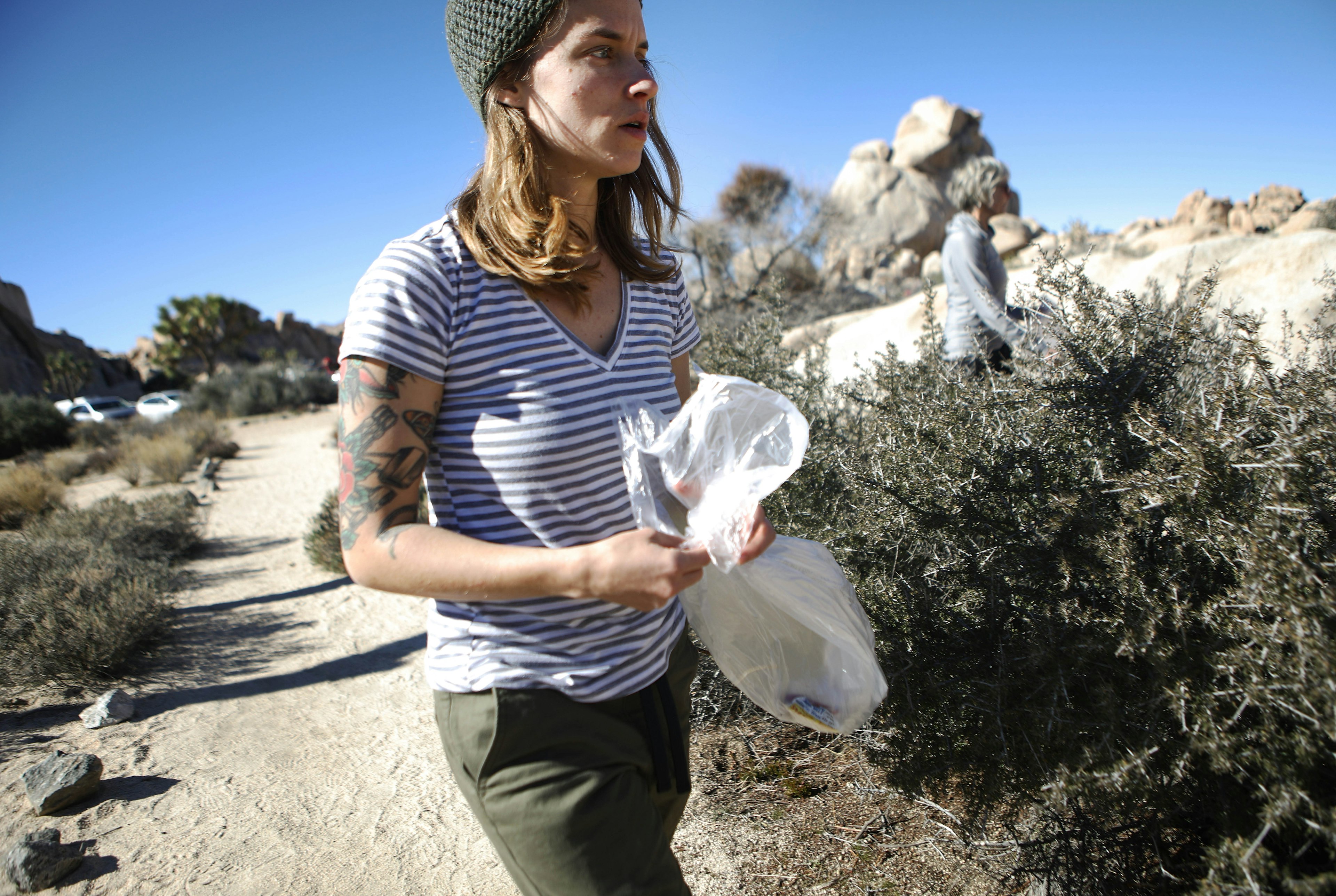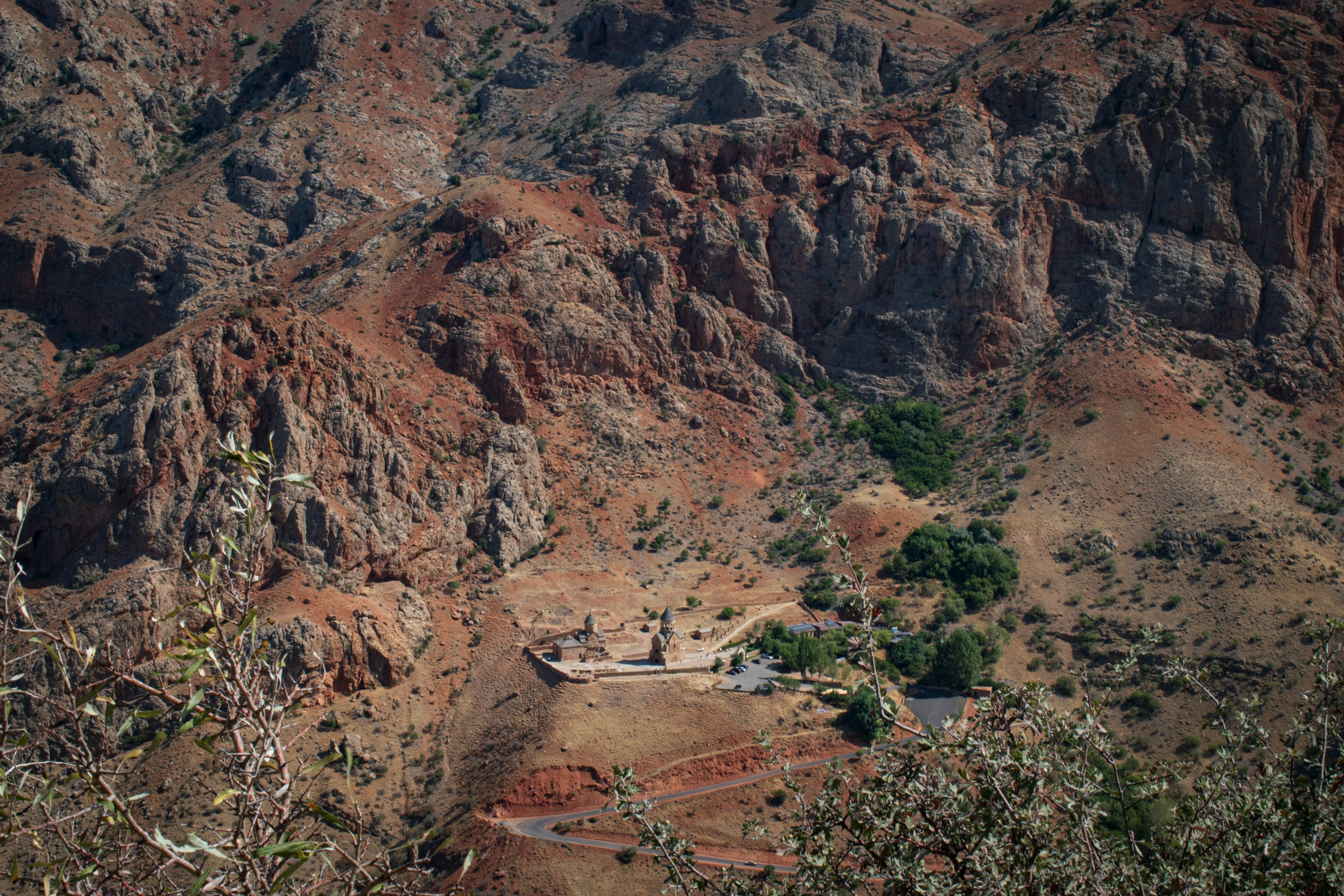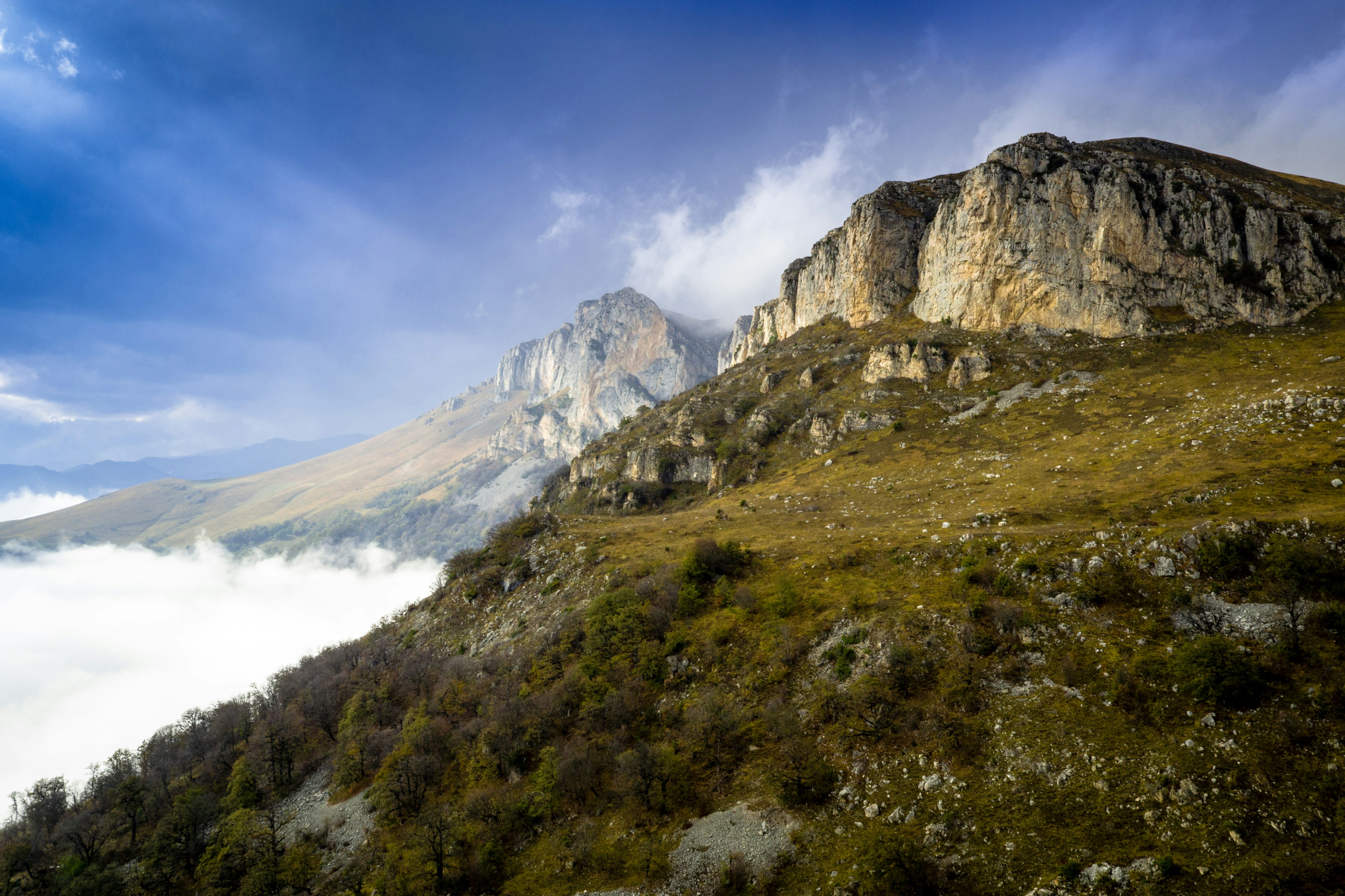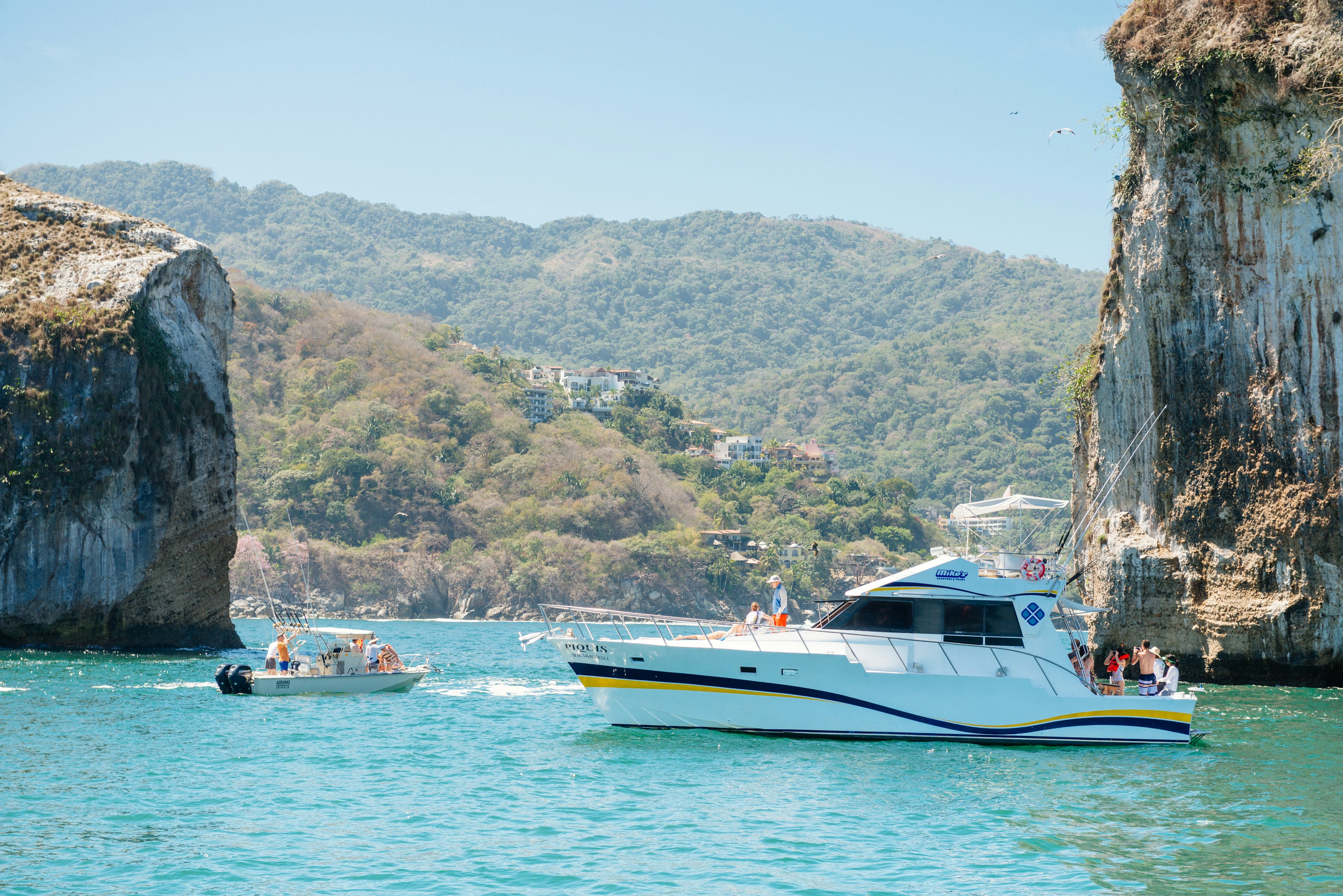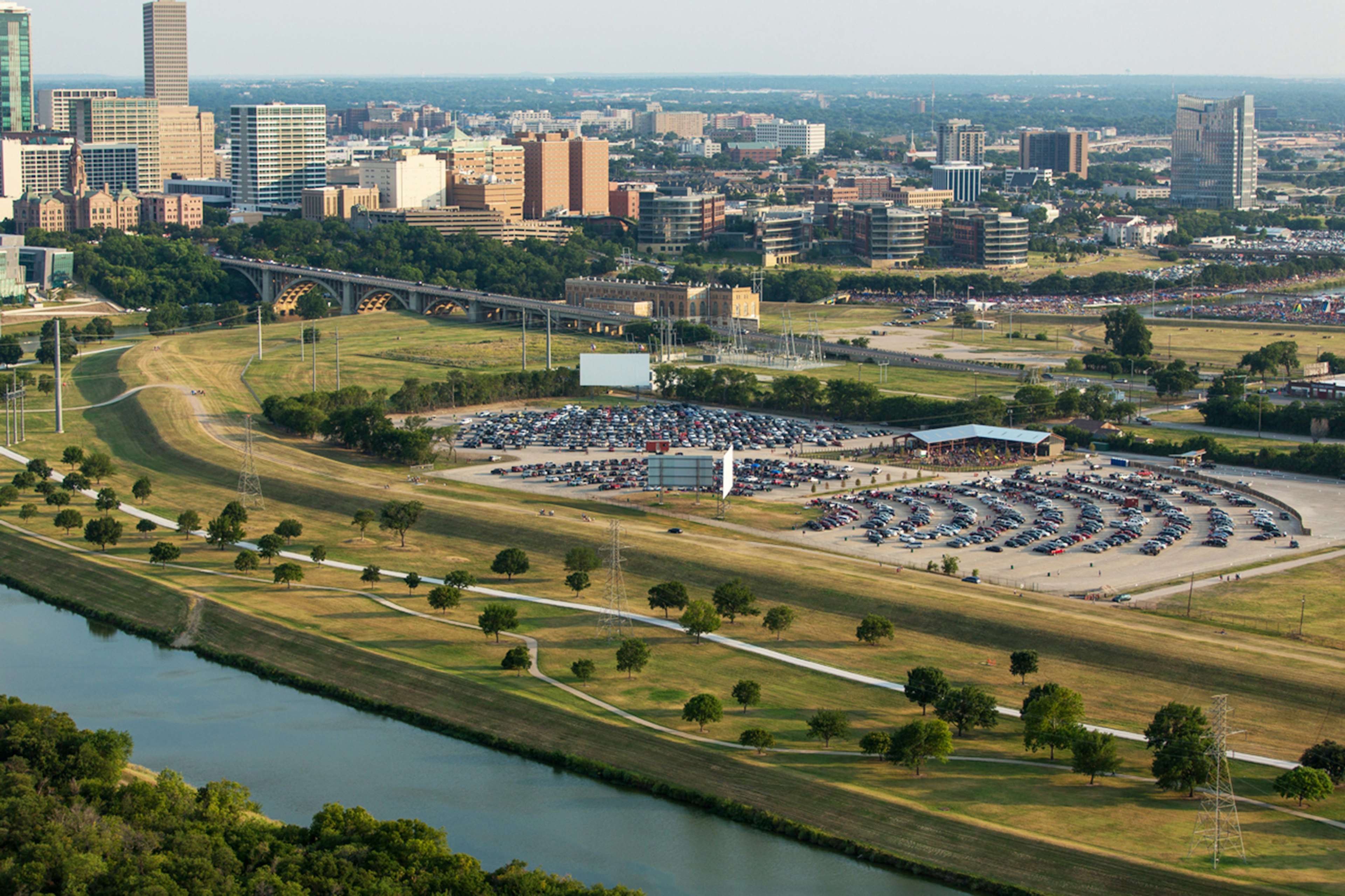It’s time to get your soak on. Although all 50 states have natural hot springs, the western half of the USA is home to some of the best natural hot springs in the country. From comfortable resorts that revolve around effervescing pools of hot water to remote thermal springs only accessible by snowmobile or dogsled, read on for a rundown of some of these hot spots for a safe, au naturel wellness experience catered by Mother Nature.

1. Iron Mountain Hot Springs, Colorado
Average water temperature: Between 96 and 108°F
Fastest way to get to the hot springs: Drive 180 miles west from Denver along Interstate 70 through the Rocky Mountains to reach the town of Glenwood Springs.
Overlooking the mighty Colorado River in the historic town of Glenwood Springs, Iron Mountain Hot Springs offers a more intimate and varied soaking experience than the nearby (and better known) Glenwood Hot Springs Resort, home to the world’s largest hot springs pool. You can choose your own adventure at the 16 geothermal mineral soaking pools here (ages 5 and up only), all connected by heated walkways. Or take younger kids to the family pool and adjacent jetted spa, where the water hovers around the 100°F mark.
All of the property’s mineral pools are fed from on-site springs, with no chemicals added. Called Mother Lode, the hottest mineral pool maxes out at around 108°F (there are markers outside each pool to let you know the heat intensity to expect). You can tickle your toes in reflexology pools with smooth river rocks at the bottom. And for the best views, look for the Garnet and Diamond pools, which have infinity edges and hang over the river in a way that might make you feel like you’re actually soaking in it.
Planning tip: Visit on a weekday at 9am, just when the springs open, for the most peaceful and crowd-free experience.
2. Homestead Crater, Utah
Average water temperature: Between 90 and 96°F
Fastest way to get to the hot springs: Drive 51 miles (less than an hour) southeast of Salt Lake City to reach Homestead Crater Mineral Dome.
As long as you’re okay with a hot-spring soak that’s not as hot as most of them (temperatures max out around “just” 96°F here), Utah’s Homestead Crater definitely delivers the biggest range of on-site experiences of any hot springs we know. Here, you not only can float in womb-like waters but also scuba dive in them (if you’re certified), snorkel and even try some SUP yoga within the beehive-shaped dome of the hot springs’ natural limestone setting.
It’s an otherworldly location for wellness, to be sure, bolstered by naturally present calcium and sodium bicarbonate in the geothermal waters that are said to soothe muscles and promote relaxation. The hole at the top of the crater lets in sunlight and fresh air, setting the scene for some pretty spectacular photos, too.
Planning tip: For the best photos, plan your visit for spring or summer when there’s less steam inside the crater and you can be sure to photograph its impressive interior expanse with good visibility all around.

3. Castle Hot Springs, Arizona
Average water temperature: Bubbles up at 115°F, with pools maintaining temperatures between 85 and 106°F
Fastest way to get to the hot springs: Drive about 55 miles (roughly one hour) northwest of Phoenix Sky Harbor International Airport to reach the resort and hot springs.
Tucked into a scenic canyon in the Bradshaw Mountains just an hour from Phoenix, Castle Hot Springs has been luring tourists since the late 1800s – and Indigenous peoples for far longer – with its healing waters. Now an all-inclusive luxury wellness resort, this destination is well worth an overnight stay, thanks to exceptional stargazing at night, a thrilling onsite Via Ferrata adventure course and (naturally) 24-hour access to mineral hot springs that cascade across three pools of varying temperatures.
Open to resort guests only, the geothermal hot springs here are rich in calcium and nerve-calming magnesium as well as lithium, which has been called the “happy mineral” for its mood-stabilizing properties. Take a soak surrounded by towering saguaro cacti, palms and layer upon layer of weather-worn rock, colored purple and rusty red from the spring’s mineral content.
Planning tip: After a long hike on the property, soak in the hot springs to ease muscle soreness and joint pain. Bicarbonates in the water help remove lactic acid from your muscles. To have the hot springs to yourself, arrive before 6am or around 8pm, when other guests are likely still asleep or at dinner.

4. Chena Hot Springs, Alaska
Average water temperature: Outdoor pools average about 106°F
Fastest way to get to the hot springs: Fly to Fairbanks and drive (or take the resort’s shuttle) 62 miles northeast to Chena Hot Springs.
If there’s any state in the US that naturally begs you to seek out a hot spring, it’s Alaska. And one of the most famous ones in the state is found 150 miles south of the Arctic Circle, near Fairbanks, at Chena Hot Springs. If your luck holds here during the darker months of the year, from late August through late April, you might even get lucky and catch the northern lights swirling overhead while you soak.
An indoor pool offers cooler waters, yet the steamier outdoor wading lake – supplied by geothermal waters with no added chemicals and surrounded by boulders – is far and away the most spectacular spot to dip. The sandy bottom is comfortable on your feet, and you can push along the bottom or stroll the lake until you find a spot with the perfect temperature.
Planning tip: While there’s lodging onsite at the hot springs, there are better places to stay in and around Fairbanks. (We love Borealis Basecamp.)

5. Avalanche Ranch Hot Springs, Colorado
Average water temperature: Pools range from 93 to 104°F
Fastest way to get to the hot springs: Drive 208 miles (4 hours) west of Denver International Airport to reach Avalanche Ranch Hot Springs.
You can come as a day-tripper or stay the night in adorable cabins (including the Chuck Wagon, which sleeps only two people and sits atop actual wheels) at this inimitable hot springs resort in Colorado’s sublime Crystal River Valley. Surrounded by mountains in the White River National Forest, Avalanche Ranch Hot Springs has three hot-spring pools on the property of varying sizes – all of which cascade, waterfall-like, down the mountainside. If you’re staying at the property, access to the hot springs is included in your nightly rate and you can access the pools around the clock.
Planning tip: The ranch hot springs are closed for cleaning on Wednesdays, but you can carve out your own little pool to sit and soak right on the banks of the Crystal River at Penny Hot Springs, just south of the cute town of Carbondale.
6. Orvis Hot Springs, Colorado
Average water temperature: Outdoor pools average about 106°F
Fastest way to get to the hot springs: It’s a roughly 292-mile drive southwest of Denver International Airport, through Gunnison and Montrose, to reach Orvis Hot Springs.
Ten indoor and outdoor soaking pools beckon uninhibited lovers of lithium-infused water to this clothing-optional oasis just north of Ouray in southwestern Colorado. Water temperatures in the various pools at Orvis Hot Springs run the range from a nippy 65°F to a steamy 114°F in the “lobster pot,” so you can try alternating hot and cold dips if you really want to get your blood flowing.
The hot springs were long on the radar of the Tabeguache band of the Utes, who considered the spot a sacred healing destination. Today, it’s a free-spirited crowd that largely chooses to take the waters – sans cover-ups. Note: if you’re worried about where your gaze might wander in this liberating environment, it will be hard to resist…the views of the gorgeous San Juan Mountain views all around.
Planning tip: After a long soak, splurge on a massage inside one of the onsite yurts.

7. Hot Springs State Park, Wyoming
Average water temperature: The water in the bathhouse hot spring is 104°F
Fastest way to get to the hot springs: Drive 85 miles (1.5 hours) southeast of Cody, Wyoming to reach Hot Springs State Park.
What’s better than a hot spring surrounded by nature in a state park? Free-entry hot springs surrounded by nature in a state park. That’s right: there’s no one taking tickets or sliding your credit card to access the Wyoming State Bath House at Hot Springs State Park in Thermopolis, Wyoming. Indoor and outdoor mineral hot springs flow up from the earth at 128°F and are cooled to 104°F for visitors’ therapeutic bathing benefit. Of course, you have to first get to Hot Springs State Park, in the remote north-central reaches of the state. It’s well worth the trek not only to enjoy the springs at the bathhouse and see the too-hot springs flowing along the Big Horn River but to spot big-horned animals, too – the park is home to a managed herd of bison that can be easily observed.
Planning tip: Find your way to Ava’s Silver and Rock Shop in Thermopolis to shop for a mind-boggling range of rocks, minerals and fossils – all at largely affordable prices.
8. Benton Hot Springs, California
Average water temperature: The water comes out at 140°F; adjustable in individual pools
Fastest way to get to the hot springs: On the border with Nevada, the hot springs are most easily reached by flying into Las Vegas and driving 282 miles (roughly 4.5 hours) northwest.
Camping alongside your own private hot spring-fed-soaking tub with spectacular views? We’re into it. The 11 private hot spring-fed soaking pools at Benton Hot Springs in California’s Mono County are available for overnight rentals and sit astride your own picnic table and fire pit for roasting s’mores post-soaking session. Feel free to pitch a tent (or show up in an RV or camper) for the night to linger longer and enjoy the dark skies overhead. (There’s an inn here with a few rustic rooms, too, but camping is where it’s at).
Each of the private hot tubs has a different look and views – some are elevated, others sunken into the ground – but they’re all fed with natural hot spring water that flows into the pools at 140°F, which you can adjust to a tolerable feel with your tub’s hoses.
Planning tip: There’s no restaurant on site, so if you’re not into campfire cooking, drive roughly 40 miles (40 minutes) south to Bishop, where Mountain Rambler Brewery serves up excellent burgers and craft beers.
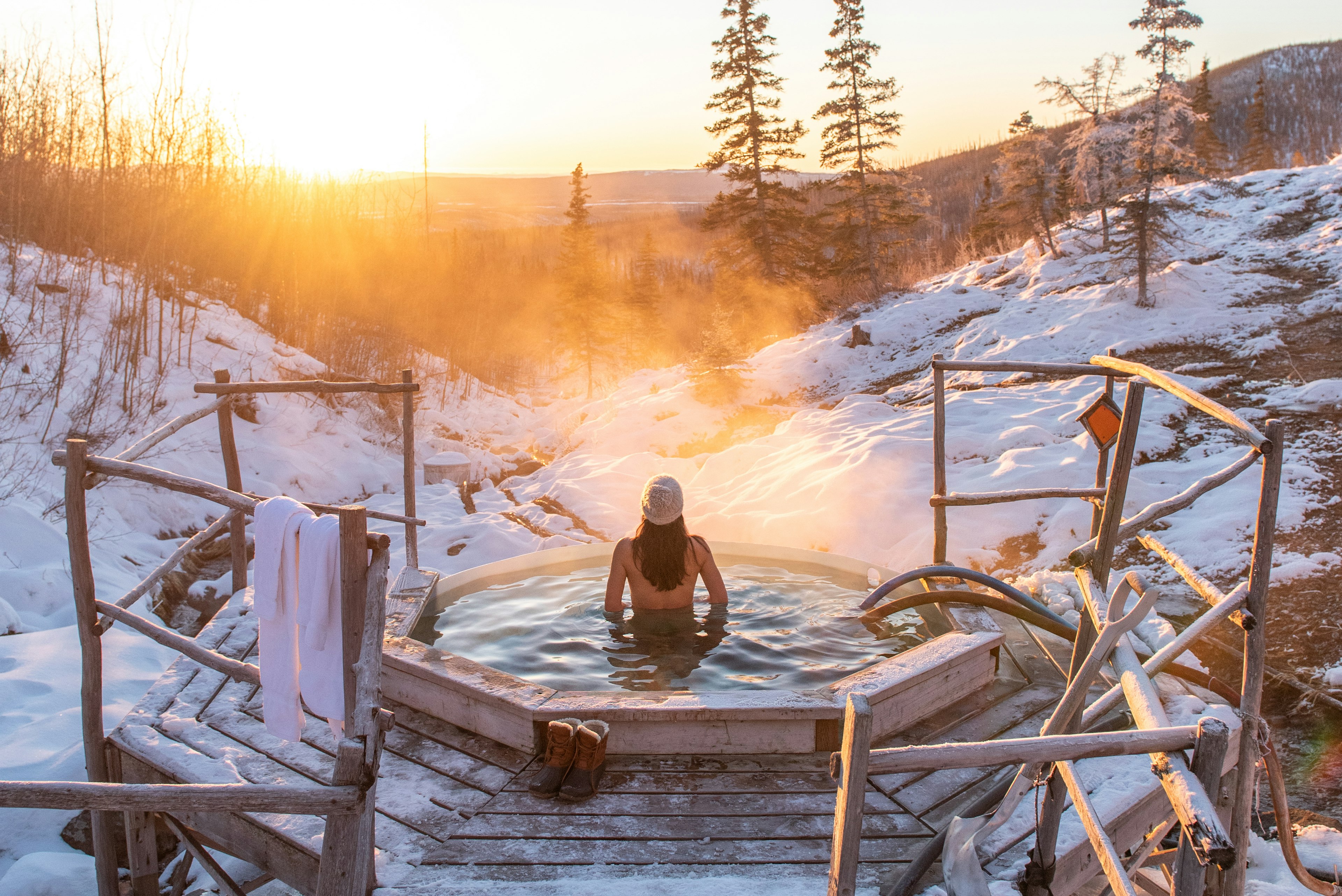
9. Tolovana Hot Springs, Alaska
Average water temperature: Between 125 and 145°F, then cooled for soaking
Fastest way to get to the hot springs: Arrive by helicopter from Borealis Basecamp in Fairbanks, on dog-sledding tours or, during the summer, by hiking just over 10 miles from a trailhead some 100 miles by car from Fairbanks.
Whereas Chena tends to draw the aurora-seeking masses to its sprawling outdoor hot pool, this more remote Alaskan hot-spring destination, 45 miles as the crow (or helicopter) flies north of Fairbanks, makes you earn it – which means hiking or flying in during the summer months, or arriving by dogsled or on skis when it’s snowy. As you might imagine, arriving by dog sled at Tolovana Hot Springs pretty much takes the cake. You can head out with Arctic Dog Aventure Co. to reach the springs on multi-night dog sledding expeditions that promise one awesome adventure (and often the northern lights, too).
Borealis Basecamp can also get you to the hot springs on day trips by helicopter, which is equally splendid. The hot springs come out of the earth at between 125 and 145°F, and you soak to enjoy them in small, hot-tub-like pools. Yet what makes this place special is being deep in the wilderness of northern Alaska, so comfortable in such very wild surroundings.
Planning tip: If you dare, be brave and take it all off. The skin feel is exceptional. And when are you ever going to find yourself in such a remote place for hot spring hopping again?
10. Burgdorf Hot Springs, Idaho
Average water temperature: Between 96 and 113°F
Fastest way to get to the hot springs: Drive 138 miles (roughly three hours) north of Boise through the mountains of the Payette National Forest to reach the hot springs.
Topping the list of Idaho’s most epic and historic hot springs, Burgdorf Hot Springs is on the National Register of Historic Places and delivers a true western experience. Open to guests who overnight in the rustic collection of onsite cabins as well as day visitors who register their visits in advance, the springs are surrounded by the lodgepole-pine-covered slopes of the Salmon River Mountains and original wooden structures built by miners in the 1800s.
Hot water gushes up from the ground at 130 gallons per minute into the hottest soaking pools – called lobster pots – from which you’ll emerge pink as a cooked crustacean. For a soaking experience where you’re likely to last longer, float with a pool noodle in the larger, pebble-bottomed main pool, which is cooler but still plenty balmy – and let the natural lithium work its magic.
Planning tip: While the hot springs are open year-round, they see far fewer crowds during the winter months and early spring (December to April), when the road is closed to car traffic and most visitors arrive by snowmobile or on skis.
11. Durango Hot Springs, Colorado
Average water temperature: Between 99 and 112°F
Fastest way to get to the hot springs: Drive 345 miles southwest from Denver, or fly into Durango-La Plata County Airport and drive 23 miles north.
Located in the southwest corner of Colorado just minutes from the city of Durango, the newly redesigned and expanded Durango Hot Springs Resort + Spa features a whopping 32 hot springs pools. Previously known as Trimble Hot Springs, the hot springs may have a new name and look, but it also has a long history dating back to the Ancient Puebloans and Ute people.
The variety of experiences offered at Durango Hot Springs is what makes it one of the best hot springs in Colorado. From a 25-meter pool to cold plunges and private Japanese-inspired soaking tubs, there are plenty of relaxation opportunities for families, couples and solo travelers accompanied by breathtaking mountain views. Once you’ve dried off, guests can enjoy spa treatments and live music.
Planning tip: The hot springs resort doesn’t currently have lodging, but there are plenty of historic hotels to stay at just nine miles south in downtown Durango, like the Strater Hotel or General Palmer Hotel.
12. Yellowstone Hot Springs, Montana
Average water temperature: Between 98 and 105°F in the hot springs and 60 to 65°F in the cold plunge
Fastest way to get to the hot springs: Fly into Bozeman Yellowstone International Airport and drive east on Interstate 90 for about 30 miles. Then go south on US-89 for about 45 miles.
Drive about 10 minutes north of Yellowstone National Park to Yellowstone Hot Springs, which contrary to its name, is not part of the national park. The family-friendly hot springs are open 12 hours daily except Monday. The facility has three pools, including a cold plunge, in close proximity for easy access. Plus, you can take in mountain and river views from the warm, relaxing springs.
Planning tip: The springs don’t take reservations. However, admission covers the entire day, so you can come and go to avoid the crowds.
13. Umpqua Hot Springs
Average water temperature: Between 100 and 115°F
Fastest way to get to the hot springs: Drive about 250 miles (4 hours) south of Portland International Airport on Interstate 5 South.
One of the best hot springs in Oregon, Umpqua Hot Springs is for those who want to be immersed in nature. The springs are located in Umpqua National Forest, and you’ll need to hike a mile from your car – that is, if you can get one of the 10 parking spots available. Be sure to check the status of the hot springs trailhead before planning your visit, especially during the winter.
Your hard work will be worth it once you reach the natural hot spring’s Instagram-famous cascading pools with wooded views. To make the remarkable experience even more worth your time, you’ll only have to pay $5 to use the springs.
Planning tip: While you don’t need to worry about safety at a regularly maintained hot spring, you’ll need to tread carefully at Umpqua Hot Springs as the surfaces around the springs can get slick. Also, be sure to bring water to stay hydrated.
14. Quinn’s Hot Springs
Average water temperature: Between 100 and 106°F
Fastest way to get to the hot springs: Fly into the Missoula Montana Airport, then drive west on I-90 for about 62 miles. Turn onto MT-135 W in St. Regis, following the road for 20 miles until you get to the hot springs.
If you want to stay, eat and soak at a hot springs resort that has it all, then head to Quinn’s Hot Springs northwest of Missoula in the appropriately named Paradise, Montana. The resort has five hot springs pools, two salt-treated pools and one cold plunge.
The mountain-shrouded hot springs are both mesmerizing and affordable at $20 during the week and $22 Friday through Sunday. You can also stay overnight on the property in one of the two lodges or 25 cabins, with views of the mountains or river. After a soak, treat yourself to a glass of wine and a gourmet dinner at the onsite restaurant or a pint at the cozy tavern.
Planning tip: If you’re not staying on the property, you must book a reservation in advance. Reservations are also recommended for the restaurant, Harwood House Restaurant.



















